
Cottage cheese is a simple fresh cheese curd product with a mild flavor and a creamy, non-homogenous, soupy texture. It is also known as curds and whey. It is made from cow's milk by draining the cheese, as opposed to pressing it to make cheese curd—retaining some of the whey and keeping the curds loose. An important step in the manufacturing process distinguishing cottage cheese from other fresh cheeses is the adding of a "dressing" to the curd grains, usually cream, which is largely responsible for the taste of the product. Cottage cheese is not aged.

Paneer, also known as ponir or Indian cottage cheese, is a fresh acid-set cheese common in the Indian subcontinent made from cow or buffalo milk. It is a non-aged, non-melting soft cheese made by curdling milk with a fruit- or vegetable-derived acid, such as lemon juice. Its acid-set form before pressing is called chhena.
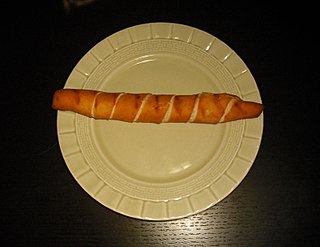
Dedito de queso or tequeño is a fried breaded cheese stick or a spear of bread dough with queso blanco stuffed in the middle, and is a popular meal or snack in Venezuela. To prepare it, the dough is wrapped around a cheesestick and formed into a breadstick so it can be fried in oil or sometimes oven-baked. Tequeños can be eaten for breakfast, as a side appetizer, or as a snack food at parties and weddings.

Queso blanco, literally white cheese in Spanish, can refer to many different kind of cheeses whose only common trait is their white color. The specific cheese referred to depends on the region.
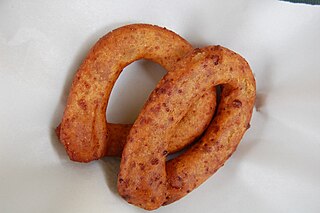
A mandoca is a Venezuelan deep fried cornmeal ring that is usually eaten with butter, cheese and coffee while still hot. It is usually served at breakfast, and it is most popular in Zulia state of the country. The mandoca is one of a variety of specialties exclusively created in the western state of Zulia.
Venezuelan cuisine is influenced by its European, West African, and indigenous traditions. Venezuelan cuisine varies greatly from one region to another. Food staples include corn, rice, plantains, yams, beans and several meats. Potatoes, tomatoes, onions, eggplants, squashes, spinach and zucchini are also common sides in the Venezuelan diet. Ají dulce and papelón are found in most recipes. Worcestershire sauce is also used a frequently in stews. Venezuela is also characterized for having large variety of white cheese, usually named by geographical region.

Anthotyros is a traditional fresh cheese. There are dry Anthotyros and fresh Anthotyros. Dry Anthotyros is a matured cheese similar to Mizithra. Anthotyros is made with milk and whey from sheep or goats, sometimes in combination. The ratio of milk to whey usually is 9-to-1. It is commonly a truncated cone, but when shipped in containers may be crumbled, as it is removed. It may be unpasteurized, where law allows.
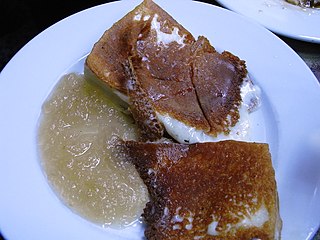
Majorero is a goat milk cheese from Spain. Similar to Manchego, this firm cheese has a milky, nutty flavour that goes well with various pear products. It is pale white in colour, and comes in large wheels. Currently it is protected under European Law with Protected Designation of Origin (PDO) status.

Honduran cuisine is a fusion of Mesoamerican (Lenca), Spanish, Caribbean and African cuisines. There are also dishes from the Garifuna people. Coconut and coconut milk are featured in both sweet and savory dishes. Regional specialties include Sopa de Caracol, fried fish, tamales, carne asada and baleadas. Other popular dishes include meat roasted with chismol and carne asada, chicken with rice and corn, and fried fish with pickled onions and jalapeños. In the coastal areas and the Bay Islands, seafood and some meats are prepared in many ways, including with coconut milk.

Maó cheese is a soft to hard white cheese made from cows' milk, named after the town and natural port of Maó, on the island of Menorca off the Mediterranean coast of Spain. Menorca is known for its cheese production and is home to one of the most respected dairy plants in Europe.
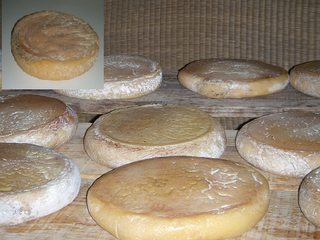
Queso de La Serena is a cheese made from Merino sheep milk in the comarca (district) of La Serena, in Extremadura, Spain. The pure sheep milk is curdled using a coagulant found in the pistils of cardoon. This ingredient lends a light bitterness to the otherwise slightly salty taste. It is aged for at least sixty days. When the cheese has a creamy consistency in the centre, it is traditionally eaten by slicing off the top and scooping out the inside with a spoon, and it is known as Torta de la Serena. If it is allowed to mature further it becomes harder, develops a stronger taste and is known as Queso de la Serena.

Cheese is a dairy product, derived from milk and produced in wide ranges of flavors, textures and forms by coagulation of the milk protein casein. It comprises proteins and fat from milk, usually the milk of cows, buffalo, goats, or sheep. During production, the milk is usually acidified and the enzymes of either rennet or bacterial enzymes with similar activity are added to cause the casein to coagulate. The solid curds are then separated from the liquid whey and pressed into finished cheese. Some cheeses have aromatic molds on the rind, the outer layer, or throughout. Most cheeses melt at cooking temperature.
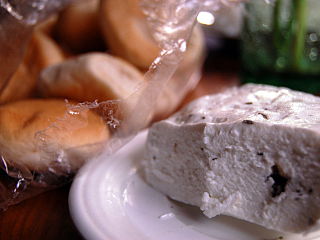
Kesong puti is a Filipino soft, unaged, white cheese made from unskimmed carabao milk and salt curdled with vinegar, citrus juices, or sometimes rennet. It can also be made with goat or cow milk. It has a mild salty and tart flavor. When an acidifying agent is used, it resembles queso blanco or paneer. When rennet is used, it resembles buffalo mozzarella. Moisture content can also vary, ranging from almost gelatinous to pressed and firm. It can be eaten as is, paired with bread, or used in various dishes in Filipino cuisine. It is usually sold wrapped in banana leaves.

Types of cheese are grouped or classified according to criteria such as length of fermentation, texture, methods of production, fat content, animal milk, and country or region of origin. The method most commonly and traditionally used is based on moisture content, which is then further narrowed down by fat content and curing or ripening methods. The criteria may either be used singly or in combination, with no single method being universally used.

Cheeses in Mexico have a history that begins with the Spanish conquest, as dairy products were unknown in pre-Columbian Mesoamerica. The Spanish brought dairy animals, such as cattle, sheep, and goats, as well as cheesemaking techniques. Over the colonial period, cheesemaking was modified to suit the mixed European and indigenous tastes of the inhabitants of New Spain, varying by region. This blending and variations have given rise to a number of varieties of Mexican cheeses. These are most popular in the country, although European cheeses are made, as well. Almost all cheese in Mexico is made with cows’ milk, with some made from goats’ milk. More recently, efforts have been made to promote sheep's milk cheeses. Most cheeses are made with raw (unpasteurized) milk. Cheeses are made in the home, on small farms or ranches, and by major dairy product firms. Between 20 and 40 different varieties of cheese are made in Mexico, depending on how one classifies them. Some, such as Oaxaca and panela, are made all over Mexico, but many are regional cheeses known only in certain sections on the country. Some of the least common are in danger of extinction.
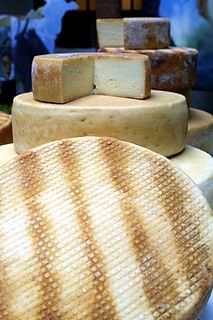
Palmero cheese is a Spanish plain or lightly smoked cheese from the island of La Palma in the Canary Islands. It is made of unpasteurised goats milk and has Denomination of Origin protection. The goats are free to graze on natural wild plants which are available all year round. The cheese is made on many small farms all over the island. It is presented in cylindrical cheeses of up to 15 kilos (33lbs).
Murcian cheese is a fatty goats' milk cheese from the Murcia region of south-east Spain. It has a Protected Designation of Origin. The cheese is made exclusively using goat's milk of the Murcian breed from registered herds which graze freely on scrub and coarse pasture characteristic of that dry geographical zone. The cheese is made in two forms:

Queso de mano is a type of soft, white cheese most commonly associated with Venezuelan cuisine. It is most commonly used as a filling for arepas and cachapa. The taste and consistency of the cheese most closely resembles that of mozzarella, but is built up in layers.

Costeño cheese is a dairy product from the Colombian Caribbean Region. It is fresh, soft, and salty. Some harder varieties have more salt.
















